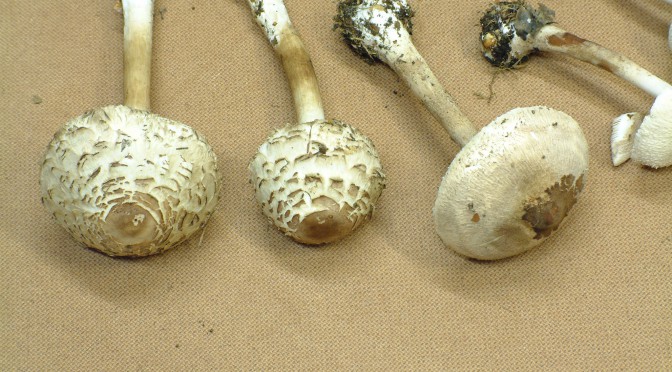It’s a disappointing autumn for mushrooms in the wood. The exceptionally dry September (and before) means that the ground is bone-dry, and that’s not great for most mushrooms which, like ourselves, are mostly water. Mushrooms have also been the losers in recent years – some of the best areas were destroyed by the thinning operations and others have become overgrown with brambles.
There are some around however.

The most common mushroom in the wood is probably the Common Yellow Russula and these can often be seen on the path edges. Stinkhorns are also quite common at this time of the year; they live up to their name – they do smell disgusting and their latin binomial, Phallus impudicus, gives a good idea what they look like!
While it would be nice to identify all the mushrooms you come across (I certainly can’t) ((but we know a man who probably can, and he’ll be leading a Fungi Foray soon!—Ed)), my real interest is in ones you can eat. Sadly, the very best edible mushrooms don’t occur in Oakley Wood. False Chanterelle are quite common, but the real ones aren’t to be found. The king of mushrooms, the Penny Bun (aka Cep or Porcini), is also missing from the wood. However, there are still some that are worth eating.

The Shaggy Parasol (Chlorophyllum rhacodes) can be found in the wood. To many people it probably looks like an archetypical “toadstool” and not something to be eaten, particularly after seeing that when you cut it, it stains red! However, it is good to eat and remains firm when cooked. Apparently some people can have stomach upsets from it, so if trying it for the first time, just have a small piece (good advice for any new mushroom). I’ve fed it to a number of people with no adverse reaction.

You can also find Wood Blewits (Lepista nuda). These are quite distinctive looking mushrooms—tan/brown on the cap and lilac gills and stem, and have a distinct perfumed/fruity smell.
There are some boletes to be found – relatives of the Penny Bun. I’ve found the occasional Bay Bolete and Red-Cracked (or Red-Cracking) Bolete. Both are edible, the Bay Bolete the better. The Red-Cracked Bolete goes mushy when cooked and is only really suitable for drying and used in sauces. Boletes are different from most mushrooms in that they have pores rather than radial gills under the cap. This makes them look a bit like a sponge. Both of these boletes have the rather alarming feature of their pores turning blue when bruised!


I think drying is the best way of using any of these mushrooms. The process intensifies the flavour and they keep for years.
And this is what it’s all about: a mushroom sauce I made for steak last week – from a dried mixture of Shaggy Parasol, Bay Bolete, Wood Blewit and Oyster. Yummy!
I’m sure everyone is aware of the potential dangers of eating wild mushrooms. If you’re not certain you know what you’re doing, don’t. Even if you do, a good piece of advice is to keep back a sample of what you’re eating, just in case. Then if you’ve made a mistake hopefully someone can identify what is really was! But there is so much information and photos out their on the internet, so use it.



Nice report !
I just would like to advice… (FROM WIKIPEDIA)
“The shaggy parasol is popularly praised as a choice edible mushroom. However, it contains toxins which can cause gastric upsets when eaten raw or undercooked, and some individuals show a strong allergic response even after cooking.
Furthermore, young shaggy parasols look identical to the poisonous Chlorophyllum molybdites (the mushroom that causes the most poisonings in North America yearly).[2] Checking the spore print is essential as C. molybdites’ print is green (older specimens have slightly green gills). As a result, this mushroom is not recommended for inexperienced hunters.”
…your choise !
Cheers
Indeed, which is why I mentioned it in my post, and advised – as with eating any mushroom for the first time – that you just try a bit first. My personal experience is that of the few people I’ve fed this mushroom to, no-one has had an adverse reaction. Nowhere that I’ve read has actually quantified the percentage of people that do have a reaction (I suspect no-one knows), so I’ve no idea how much of a risk it really is. In my opinion, enough people say that this is a excellent edible mushroom to make it worth trying. But as you say, it’s your choice.
As for Chlorophyllum molybdites, remember that information on the internet is global and may only have regional relevance. Fortunately for us, this mushroom does not occur in the UK.
The true Parasol mushroom, Lepiota procera, is the real prize – excellent to eat and no adverse reactions. Unfortunately it doesn’t occur in Oakley Wood (although I have found it in Crackley Wood).
Chris
good knowledge: but other than in Greenhouse cultivation , the green spored Chlorophyllum will not be encountered in England.
Cep( Boletus edulis ) is found here though rare
The true Chantarelle , also fruits here : though rarely.